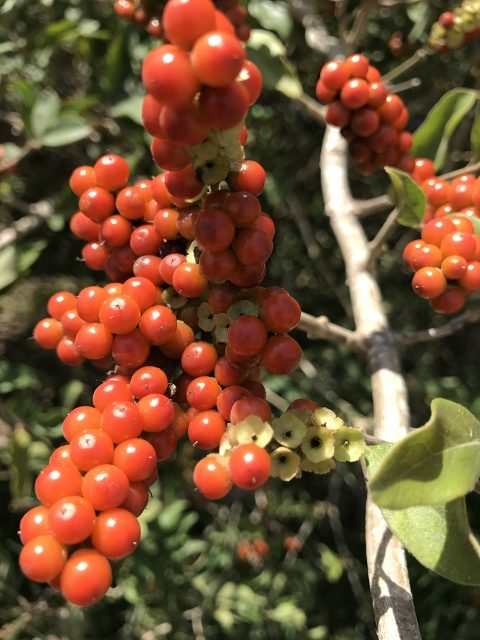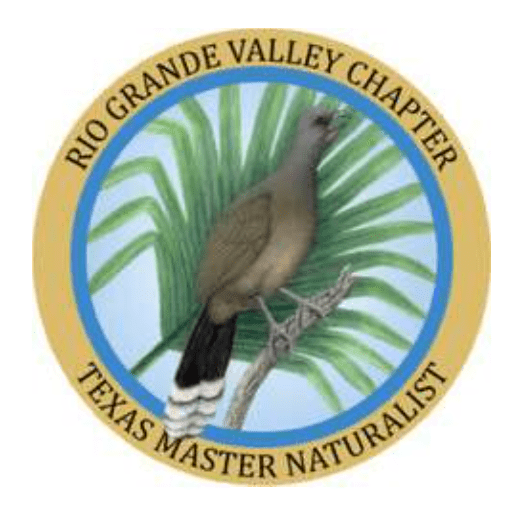Story and photo by Anita Westervelt, Texas Master Naturalist

Winter may seem mainly for the birds. January was busy with the Christmas Bird Count and backyard feeder count — which brings us to a list of the best native trees for attracting birds.
Honey Mesquite is the best all-round tree for wildlife. Seeds are eaten by jack rabbits, some quail, songbirds, various small mammals and domestic livestock. Ground squirrels, various mice and rats consume the foliage and different birds nest in the tree’s canopy, according to a USDA Natural Resources Conservation Service Plant Guide by M.C. Johnston.
Wintering-over warblers, kiskadees, golden-fronted woodpeckers, phoebes and other resident birds frequent mesquite trees, eating insects and insect larva. Bees, flies and butterflies get nectar from the flowers; the leaves are larval food for long-tailed skipper and Reakirt’s blue butterflies.
If a mesquite tree seems too large for your yard, there are quite a few native trees of varying sizes and growth rates, with different attributes, that are helpful to those wanting to attract birds.
Best shelter — anacua, Texas ebony, brasil
Best food (berries) — anacua, brasil, colima, coma, Barbados cherry, Texas persimmon — entertain no expectation of keeping the ripe persimmons for yourself
Best nectar — esperanza, butterflies, bees, hummingbirds, orioles
Best nesting — honey mesquite, ebony, anacua, potato tree
Best to keep out of your own yard — granjeno (spiny hackberry), great bird-food; greater potential for bird-planted upstarts of quick-growing thorny trees
Best for spring warblers — huisache
Best butterfly larval food — Texas ebony
Best entertainment — potato tree, Mexican caesalpinia
Best for insects — Texas ebony, anacua, retama
Best for small gardens — Texas kidneywood, whitebrush, Texas torchwood, Sierra Madre torchwood, Mexican caesalpinia
Best for giant swallowtail butterflies — both torchwoods, colima, Esenbeckia, barreta
Best for year-round blooms — wild olive
It’s not just tree-planting time. Trees are not swift-growing. If you want faster results, plant one or more Berlandier’s fiddlewood. This is a large shrub that can bloom and berry all year. It invites song birds, and raucous chachalacas, green jays, mockingbirds and more, to its branches and fruit. The flowers attract butterflies and bees.
Many native shrubs can be planted now for the great fall butterfly run: lantanas, skeleton-leaf golden eye, Turk’s cap, heliotrope, fall-blooming mist flower, yellow sophora and the Rio Grande butterfly bush (Buddleja sessiliflora is the native species).
Before you plant, read about the Valley’s native trees, shrubs and plants. A favorite book with Texas Master Naturalists is “Plants of Deep South Texas – A field guide to the woody and flowering species” by local authors Dr. Alfred Richardson & Ken King, Texas A&M nature guides. Available at many of the Valley’s nature centers.
The Native Plant Project meets monthly in Weslaco with guest speakers. Their website offers native plant handbooks that can be downloaded at https://nativeplantproject.com/
Both Valley Texas Master Naturalist chapters offer monthly educational programs. The Rio Grande Valley Chapter meets in San Benito, https://rgvctmn.org/; South Texas Border Chapter meets in Pharr, https://www.stbctmn.org/
For a list of Valley native plant growers, visit https://rgvctmn.org/rgv-plants/
